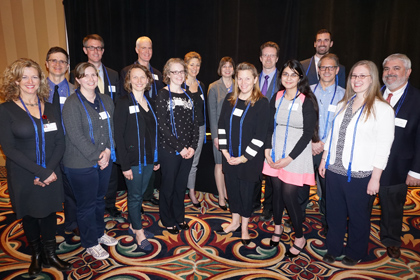
Mud Season Symposium 2016 (Courtesy Photo)
The traditional hour-long classroom lecture is giving way to team-based learning and other “active” teaching methods at the University of Vermont College of Medicine.
Faculty members heard more about this new mode of instruction during the 2016 Mud Season Educational Symposium in April hosted by the College’s Teaching Academy, which supports professional development among an interdisciplinary community of educators. The Mud Season event brings them together for workshops, presentations and information-sharing to impart the latest and most effective teaching techniques.
“We want to make sure that the doctors that we graduate are positioned to succeed in the healthcare models that will come – not the healthcare models that already happened,” says William Jeffries, Ph.D., senior associate dean for medical education.
He kicked off the symposium with an overview presentation, titled “Creating Environments for Learning,” to update faculty on some of the College’s latest initiatives. Those include an emphasis on active and team-based learning; the creation of a clinical campus at Western Connecticut Health Network’s hospitals in Danbury and Norwalk, Conn.; and the development of a Longitudinal Integrated Clerkship (LIC) in New York and Maine. The LIC will allow medical students to spend most of their clerkship year at one site, rather than rotate through several departments.
“We can no longer just use lectures for information delivery,” Jeffries says. “There is a role for lectures, but not in the way we do it now.”
With team-based learning, students prepare for class in advance, typically with a video or instructor’s lecture notes posted online. Then, they come together in small groups to apply those lessons with various exercises. Tests both before and after the team exercise show the difference in the amount of information they absorb.
“It’s leveraging the power of the group, the knowledge of the group,” says Kathryn Huggett, Ph.D., director of the Teaching Academy. Research has shown it’s a better way for students to retain what they learn, “instead of sitting in the back of the classroom and just passively taking notes,” she says.
A faculty member acts as a guide, asking questions and challenging the students as they apply the material. “We are trying to convert as many lectures as we can into an active learning environment,” Huggett says.
The springtime Mud Season symposium and companion Stick Season event in the fall have morphed from workshop-type retreats for Teaching Academy members into full-fledged conferences, with multiple presentations and breakout sessions. College of Medicine faculty lead many sessions, sharing their expertise with colleagues working at all levels of education – with medical students, doctoral students and residents. Faculty from UVM’s clinical teaching partner institutions Eastern Maine Medical Center and Western Connecticut Health Network also participated in greater numbers, Huggett says.
This year, the symposium emphasized wellness with topics focused on preventing burnout among faculty who are working physicians, or researchers who might teach all day, write grant proposals at night and run laboratories similar to small businesses, Huggett says.
“There’s some pretty sobering data” related to the consequences of stress, she says. “We’re taking those national statistics seriously.”
Wellness also applies to medical students and their experiences, satisfaction and comfort level. UVM excels in this area, but can always improve to foster wellbeing – perhaps hosting weekly events like ice cream socials, offering stress-relief programs or responding to negative feedback, Huggett says
“Part of the model of wellness is promoting resilience, whether it’s for faculty or students,” she says.
Symposium attendees explored “learner mistreatment” with the Learning Environment and Professionalism (LEAP) Committee, which the College formed to address unfair treatment of medical students and develop curriculum to prevent it. The LEAP Committee has created two videos, which depict scenarios of mistreatment, and unveiled the latest one during a presentation with colleagues from the UVM Departments of Psychiatry, Anesthesiology, and Obstetrics, Gynecology and Reproductive Sciences.
Upcoming events for the Teaching Academy include an intensive seminar on teaching and assessment on September 23; the Winter Education Retreat in early January 2017; and UVM’s hosting of the International Association of Medical Science Educators annual meeting in June 2017.
The following faculty members were inducted into the Teaching Academy at the Mud Season Symposium:
Distinguished Educator
- John King, M.D., Professor, Family Medicine
Master Teachers
- Elizabeth Ames, M.D., Associate Professor of Orthopaedics & Rehabilitation
- Erica Gibson, M.D., Assistant Professor of Pediatrics
- Felix Hernandez, M.D., Associate Professor of Surgery
- Jerry Larrabee, M.D., Professor of Pediatrics
- Stephanie Mann, M.D., Associate Professor of Obstetrics, Gynecology and Reproductive Sciences
- Christopher Morris, M.D., Professor of Medicine
- Richard Pinckney, M.D., Associate Professor of Medicine
- Christa Zehle, M.D., Associate Professor of Pediatrics
Members
- Erik Anderson, M.D., Assistant Professor of Anesthesiology
- Whitney Calkins, M.D., Assistant Professor of Family Medicine
- Lydia Grondin, M.D., Associate Professor of Anesthesiology
- Elise Hotaling, M.D., Assistant Professor of Radiology
- Molly Moore, M.D., Assistant Professor of Pediatrics
- Emily Stebbins, M.D., Assistant Professor of Anesthesiology
Protégés
- Jacquelyn Grev, M.D., Fellow, Neonatology
- Patrick Hohl, M.D., Fellow, Medicine
- Sherrie Khadanga, M.D., Resident, Internal Medicine
- Thomas Rogers, D.O., Resident, Pathology and Laboratory Medicine